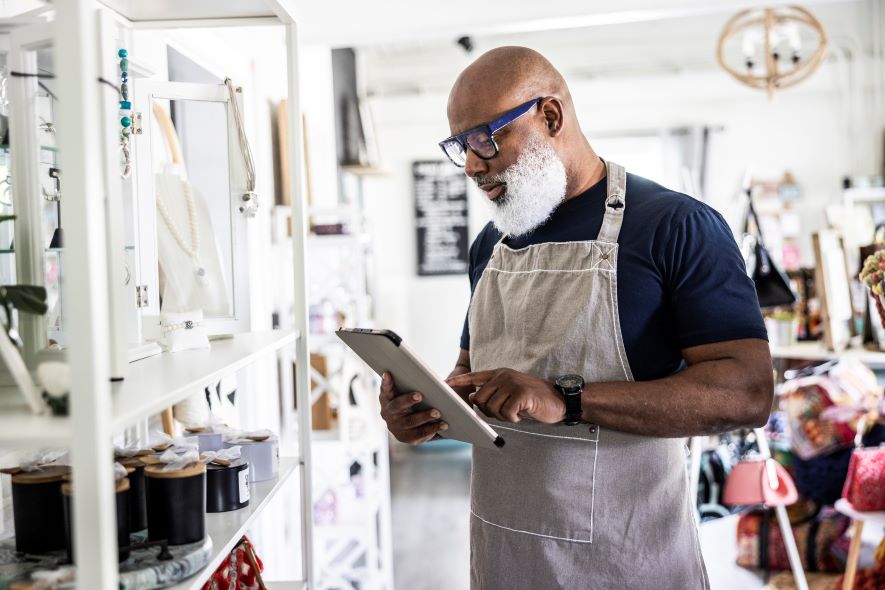The $1.9 trillion American Rescue Plan Act of 2021 aims to help the American economy recover after a long and difficult year of shutdowns and hardships related to the COVID-19 pandemic. If you’re a small business owner, here are the five things you need to know about it:
1. More businesses are eligible for PPP loans Until May 31
Not only did the Paycheck Protection Program (PPP) receive an additional $7.25 billion as part of the legislation, but more small businesses are now eligible to apply.
The program was expanded to include internet-only news and periodical publishers with more than one location. Larger 501(c)(3) organizations and veteran organizations that employ not more than 500 employees per physical location can participate now as well. The broader eligibility standards also allow larger 501(c)(6) organizations, domestic marketing organizations, and additional covered not-for-profit entities that employ not more than 300 employees per physical location to apply for program benefits.
Via a directive from the Biden Administration prior to the passage of the bill, independent contractors and sole proprietors who apply for the loan can now use “gross income” (line 7 on their Schedule C tax form) instead of “net income” as a means to calculate their loan availability, a change that will greatly expand the size of the loans for many.
Most of the other conditions of the program still apply, including second-round loans that are targeted toward businesses that have experienced a decline in revenues and an expansion in the types of expenses that can be used for forgiveness.
On March 25, Congress extended the Paycheck Protection Program application deadline. The legislation will set a new application deadline of May 31, allowing the Small Business Administration (SBA) to continue processing applications for up to 30 days past the new date.
2. There’s a new, grant program for restaurant and bar owners.
It’s called the Restaurant Revitalization Fund, and it is designed for restaurants, bars, food stands, food trucks, food carts, caterers, saloons, inns, taverns, lounges, brewpubs, tasting rooms, taprooms and any licensed facility or premise of a beverage alcohol producer where the public may taste, sample, or purchase products, or other similar place of business in which the public or patrons assemble for the primary purpose of being served food or drink.
Those entities can receive up to $10 million as compensation for any reduction in revenues they experienced in 2020 compared to 2019. The money must be spent on certain things like payroll and operating costs.
The legislation allocated nearly $29 billion to this fund, with $5 billion set aside for eligible applicants that have 2019 gross receipts of $500,000 or less. The bill also charges the Small Business Administration (SBA) with awarding grants in “an equitable manner to eligible entities of different sizes based on annual gross receipts.” During the first 21 days of the grants, the SBA will prioritize applications from restaurants owned and operated or controlled by women, veterans, or socially and economically disadvantaged individuals.
Applications for the fund are not available as of this writing but will eventually be found on the Small Business Administration’s website.
3. More grants are targeted at businesses located in low-income communities.
A low-income community is generally defined as where the average income of its residents is 50 to 80% of the average income of its surrounding communities. If the SBA determines that your business is located in one of these areas, then you may be eligible for a special grant.
The bill designated $15 billion for grants for businesses located in low-income communities that have no more than 300 employees and that have suffered an economic loss of more than 30%, as determined by the amount that the entity’s gross receipts declined during an eight-week period between March 2, 2020, and Dec. 31, 2021, relative to a comparable eight-week period immediately preceding March 2, 2020.
In addition, and no later than 14 days after the American Rescue Plan Act is enacted, the SBA must initiate a two-week period of accepting applications from any applicants that previously applied for targeted Advances under the Economic Injury Disaster Loan program and, because of lack of funds, did not receive the amount to which they were entitled.
The SBA can also make grants of $5,000 to “severely impacted” small businesses, which are eligible entities that have suffered an economic loss of more than 50% and have no more than 10 employees. Following that, the SBA can make $5,000 grants to “substantially impacted” businesses, which are those with no more than 10 employees that can demonstrate a loss of between 30% and 50%.
If you’re in an affected area, you can apply for these grants directly on the Small Business Administration’s website.
4. A new tax credit will help pay for your employees’ health insurance.
Because it’s been around for so long, many employers and their workers recognize the Consolidated Omnibus Budget Reconciliation Act of 1985, better known as COBRA. The Act allows employees to continue their health care coverage with their employer for a set period of time even after parting ways by continuing to pay their health insurance premiums.
When companies were involuntarily forced to lay off workers as a result of the pandemic, many workers risked losing their health coverage because they couldn’t afford the premiums. The American Rescue Plan Act now provides businesses with a tax credit that will effectively reimburse them for the cost of covering these premiums. The credit expires on September 30 and comes with other limitations, so it’s best to speak to your tax or payroll advisor about your particulars.
5. Finally, two additional (and generous) tax credits have been extended.
The Employee Retention Tax Credit allows companies who were either partially or fully shut down in a quarter or experienced a revenue decline of more than 20% in any quarter of 2021 (or 50% in any quarter of 2020) compared to 2019 to receive a generous (up to $7,000 per employee per quarter in 2021) tax credit against the payroll taxes owed. The credit can be taken even if you’re participating in the Paycheck Protection Program (although you can’t use the same payroll amounts to both calculate forgiveness and for the credit) and is calculated on your quarterly federal 941 payroll tax return. What’s great about this credit is that it’s refundable – if the credit is larger than the taxes owed you can get cash for the difference.
The American Rescue Plan Act extends this credit through December 31.
Although the requirements of the Families First Coronavirus Response Act became voluntary in 2021, if you’re still providing compensation to employees who miss work because of COVID-related illness to themselves or family members, you can still claim the tax credit associated with the Act to get reimbursement. Eligible reasons for missing work have been expanded to now include vaccinations and their side effects.
This credit is also taken on your quarterly federal 941 payroll tax return and has now been extended through September 30.
***
All of the above changes are in addition to existing federal stimulus and tax incentives related to the COVID, including the Economic Injury Disaster Loan Program, The Shuttered Venue Operators Grant Program and the Work Opportunity Tax Credit. Many states, cities and private organizations are also providing grant and loan programs for small businesses, so it’s worth searching in your area.
There is plenty of sorely needed help for small businesses to help us recover and emerge from the pandemic, but it’s up to us to go after it. We encourage you to pursue all the help that’s been made available to support your business.
Next Steps: Want to learn more? Sign up for the Small Biz Ahead newsletter to receive a weekly roundup of the latest tools, trends, and resources.






Great read! I was left in the dust by my employer (laid off March 2020) who collected PPP and paid her family and bought real estate in Florida. Survival mode kicked in for me and I focused on my Etsy shop, growing sales in 2020 over 2019 300%+. Now I’m stuck because I want to make this my life, but I don’t qualify for any loans to grow my business even further. I wish the SBA would make a program for growing businesses that rose from covid-19, there’s probably a bunch of us.
There are grants available by the SBA for certain small businesses that may apply.
You should also look for grants in your state or city.
Also, consider applying for an SBA Section 7a or 504 loan – banks are guaranteed and there are forgiveness provisions.
Also – google “etsy small business grants” and you’ll see some other options.
Hope this helps.
Hi, my company was established pre-Covid but began operations Oct 2020 and since have hired a lot of employees. I know I am not qualified for PPP but can I claim the Employee Retention Tax Credit?
You can but I’m not sure you’ll be happy with this answer. That’s because to qualify you would have to show a revenue loss of more than 20% in 4Q 2021 compared to 4Q 2020. Do you think that’s going to happen?
I applied for the second round of the EIDL. I had more than one business but am only allowed one business type code under the corporation. I changed to what is my primary business now and was told I wasn’t eligible due to the code change even though I’ve had multiple businesses for a number of years. Is there any way to have this reviewed?
Hi Kat, you’re going to have to call SBA directly on this. I think they’re catching up.
Thanks for the info.
You’re welcome, Victoria! We’re glad you enjoyed the article.
Does the Restaurant Revitalization Grant include private clubs that serve food and beverage to some public (non-members). We employ people too and are equally in trouble.
It does include them. But hurry up and apply. I’m already hearing the funds are going to run low soon.
Thanks for the response Gene. Does it matter that we are also a 501c 7 nonprofit ?
Bob – Unfortunately, non-profits can’t apply for this sorry.
The PPP funding ran out as they were supposedly trying to fund my loan and said “my bank had rejected the attempt to process the deposit.” My bank said that couldn’t be possible. Now what?
Apply for a special grant on the SBA website or an Economic Injury Disaster Loan on the site: http://www.sba.gov. Also, even though funding was closed last week, the SBA should still be able to honor any loan apps from before then so you should be pushing your lender harder.
My company recently received a first round PPP loan in 2021. When my company tried to apply for a second round PPP loan in 2021, it was informed that a company could only make one PPP loan application in each year. Seems highly unfair to me. Any way around this?
I haven’t heard of that rule and I don’t believe it’s accurate. I would recommend that you try again but unfortunately the funding window has closed. You should look into economic injury disaster loans and grants on sba.gov.